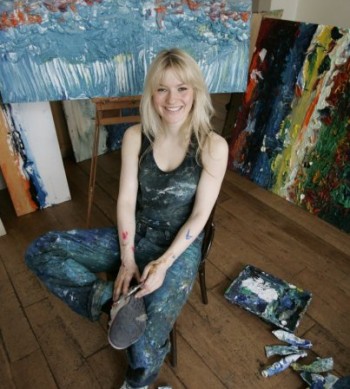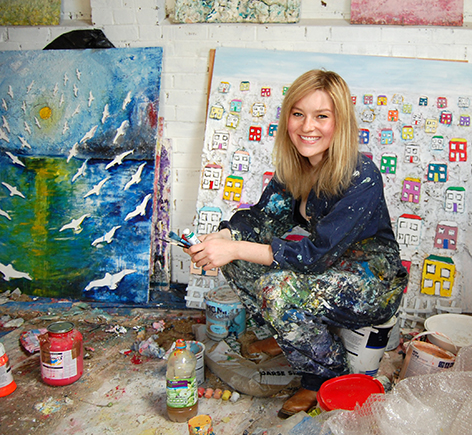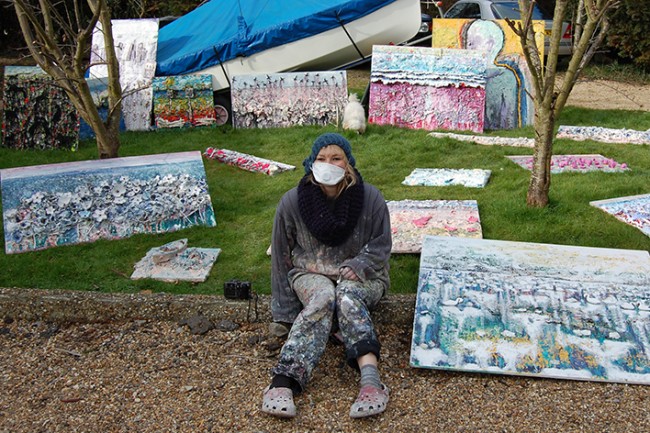 home
about
artists
exhibitions press
contact
purchase
home
about
artists
exhibitions press
contact
purchase |
|
|
SCARLETT
RAVEN
When did you first discover a talent and passion for painting? My earliest memories in life are of me drawing and painting. I can’t remember a time when I wasn’t collecting things and discovering new textures. I had books full of things I had found. I suppose all children do that to express themselves but I never stopped. My mother put a portfolio together when I was 4 and I have been updating it ever since. My uncle, aunt and cousin dedicated their life to making art. They attended Slade and St Martins. I was surrounded by people with great imaginations who encouraged me and inspired me. I was extremely lucky. When I was 6 I remember scratching chalk to collect its dust. I must have gone through a lot of chalk because I remember a massive pile. I thought the dust was beautiful. I find myself in the studio to this day doing similar things. Has dyslexia been a help or a hinderance to your artistic practice? I found Maths and English really difficult at school and Art was where I felt proud and felt I was accomplishing things. It is magical. And has always been the most natural thing to do. When I was 16 we had a GCSE art exhibition at school and a woman cried when she saw my painting (hopefully it was because she liked it!). I remember it well. The painting was called ‘Rebirth of the Mind’ and was about breaking through the hard shell you build to protect yourself. I had always wanted to be an artist for myself, that day I realised the joy and completion I felt from making can have an effect on other people, like other artists paintings have had on me. This was a big deal for me. During my imitation phase (early teens) I discovered the Impressionist, Surrealist and Expressionist artists. In particular Frida Khalo, Salvador Dalí and Van Gogh. The paintings ability to hold someone’s raw emotions was electrifying. For that emotion to then break its boundaries and reach the viewer was remarkable. When I was young and still to this day paintings become my friends. I would stare at them and not feel alone. Great paintings make me feel safe. Looking at a Van Gogh was like watching an incredible film I looked at it for hours and these were just photographs of the real thing. I grew up a lot through paintings they were like lessons and experiences. Your parents are both successful artists, although in completely different fields (composer and writer). How do you think this has influenced you in the way you create? It’s definitely made me the person I am. I grew up in music studios. Members of Pink Floyd and Roxy Music played at my 6th birthday party. Music is very important to me I hear when I paint. It is my way of making music. And when I hear music I see images. I grew up with the idea that being a musician, artist, and writer wasn’t a dream, it was a reality. I am very grateful for that. Although it makes for an unstable life it definitely makes for a fulfilling one. Because of this it was never a question, it was a fact, I am a painter. The danger of this has been throughout my life when I have doubted myself, which is common for artists, I have doubted my complete self. That’s a dangerous place to be in. I think I can safely say art is my life. And that is the way it should be.
Nature exposes and represents emotions like nothing else. It is breath-taking, stunning, beautiful, terrifying and deadly. It’s the root of everything. You feel irrelevant, insignificant, powerless to its capabilities and force and vastness, yet part of something magical, belonging to something important, bigger than yourself. Mightier than anything you have ever experienced. Safe. Nature exposes all lights. As a platform for a painting it is perfect. Life inspires me. I am hugely interested in psychology. Thoughts that trigger emotions and emotions that trigger thoughts. Memories, experiences, senses, movement, geometry, science, history, the fact we exist is remarkable. Patterns, behaviour, socially as well and individually. Paintings that tell stories, beginnings and ends. Relationships between things are a big factor in my work. Conversations. Willingness. Belief. I have anxiety, in my twenties it has been quite severe. This has led me to think a lot, force myself to exist and learn to exist. I think this reflects in my work when things have been good they have been superb when they have been bad they have been really awful. Bringing us back to the lights and shades of nature, life. Anxiety creates heightened emotions you become sensitised, prolonged anxiety can distort your sight, balance, memory, ability to talk or function. Life being threatened is definitely visible in my work. Nothing is taken for granted in my paintings. The desire to live, breath and succeed is present. This brings me back to my research into emotions and how to express them through paint. My experiences have definitely helped make me a better painter. As painting has made me a better person. Your style is definitely one of a kind. Using a wide variety of techniques your pieces are always very chromatic and full of textures. Would you say your art is enjoyable for any kind of audience? I get surprised, people that aren’t really into art like my work. Also people who swear they only like traditional realism like my work too. Obviously there are going to be people who don’t understand or like what I do. It’s definitely a personal thing. My work always makes an impact, it never goes unnoticed. I want my paintings to reflect and trigger the viewer’s emotions, dreams, desires, ambitions. I think I’m successful in that. But of course I’ve got a long way to go. My favourite quote is from Henry Moore I think it goes something like this, ‘Dedicate your life to something and make sure its something you can never do’. Why did you decide to use the 3D element in your pieces? My favourite artists use 3D elements to their work, Anslem Keifer and Van Gogh. It feels like the painting is reaching out to you. Asking for your hand, for you to go and join it. I love the fact that as you move around the painting or there is a movement in the room, the light and perspective changes. It becomes a set and the viewer takes the lead role. The painting moves like a film you can hear it, smell it, feel it. 3D paintings speak to me. I also want the painting to take on a heart beat of its own. Remember, paintings are my friends. They are alive. And the more support they get to be resuscitated the better. The space, the room the work is in also becomes important, it is no longer a painting but an atmosphere a place. You can walk into it.
I usually work on a group of paintings at once. The drying times and journeys of each painting need time and space to develop, they also reflect a mood or idea which I am for ever changing so I need several works on the go, to be able to express these ideas and moods without destroying the previous idea. I also get obsessed by certain images and when they are ready to come out. I experiment with all different situations, compositions, colours, perspectives, dialogues within this image. And out of ten, one may be worth keeping and expanding on. I’ve had works in my studio for 5 years before I have shown them. Having studied in the Central Saint Martins, you must have rubbed elbows with some really talented people. Do you prefer showing along with other artists or do you feel more comfortable by yourself? Usually I prefer my own solo shows but when there is a running theme and dialogue and respect between the group of artists work, and when the other artists work is amazing it is an honour. The work needs to speak to each other and be cleverly chosen and cleverly positioned, then it is stunning. A curators job is very important. A good example is ‘Scape’, with View Gallery , its fantastic. Some time ago, you were defined as Prince Harry’s favourite artist. Other famous personalities (such as Orlando Bloom and Mark Owen of Take That) have reinforced your status as one of the most influent young artists. Do you think that kind of recognition helps, or pressures you to please expectations? Recognition is amazing and I don’t take it for granted at all. It enables you to make sales and buy more equipment. Artists need audiences to grow, to either make them question their work or fight for it and defend it. How did you end up creating the cover for a Roxy Music album? Andy Mackay is a fan of my paintings, he owns two. He had seen my album art work I had done previously for a band called ‘The Wiredaisies’ managed by Jim Beach (manager of rock band Queen). He asked me. Do you plan to build on your current success with a similar painting style or maybe a change to explore other methods, techniques or themes? I am experimenting all the time, you never stop experimenting. I paint from my heart and my pieces are always recognisably me. I am very lucky. I have complete freedom in my work. And that is important as this freedom is reflected in the final product. The only person I am frightened of disappointing is myself. Because my paintings mean everything to me. Thank you. |
|
|
|
|

 Nature is
always present in your work. It seems that you feel intrinsically
related to it. What else moves you to create?
Nature is
always present in your work. It seems that you feel intrinsically
related to it. What else moves you to create? Is there a
special routine you follow in the process of starting a new piece?
Is there a
special routine you follow in the process of starting a new piece?